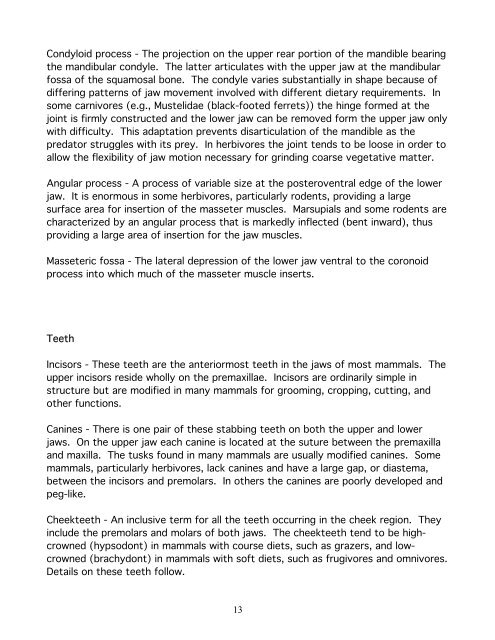TABLE OF CONTENTS - National Zoo
TABLE OF CONTENTS - National Zoo
TABLE OF CONTENTS - National Zoo
You also want an ePaper? Increase the reach of your titles
YUMPU automatically turns print PDFs into web optimized ePapers that Google loves.
Condyloid process - The projection on the upper rear portion of the mandible bearing<br />
the mandibular condyle. The latter articulates with the upper jaw at the mandibular<br />
fossa of the squamosal bone. The condyle varies substantially in shape because of<br />
differing patterns of jaw movement involved with different dietary requirements. In<br />
some carnivores (e.g., Mustelidae (black-footed ferrets)) the hinge formed at the<br />
joint is firmly constructed and the lower jaw can be removed form the upper jaw only<br />
with difficulty. This adaptation prevents disarticulation of the mandible as the<br />
predator struggles with its prey. In herbivores the joint tends to be loose in order to<br />
allow the flexibility of jaw motion necessary for grinding coarse vegetative matter.<br />
Angular process - A process of variable size at the posteroventral edge of the lower<br />
jaw. It is enormous in some herbivores, particularly rodents, providing a large<br />
surface area for insertion of the masseter muscles. Marsupials and some rodents are<br />
characterized by an angular process that is markedly inflected (bent inward), thus<br />
providing a large area of insertion for the jaw muscles.<br />
Masseteric fossa - The lateral depression of the lower jaw ventral to the coronoid<br />
process into which much of the masseter muscle inserts.<br />
Teeth<br />
Incisors - These teeth are the anteriormost teeth in the jaws of most mammals. The<br />
upper incisors reside wholly on the premaxillae. Incisors are ordinarily simple in<br />
structure but are modified in many mammals for grooming, cropping, cutting, and<br />
other functions.<br />
Canines - There is one pair of these stabbing teeth on both the upper and lower<br />
jaws. On the upper jaw each canine is located at the suture between the premaxilla<br />
and maxilla. The tusks found in many mammals are usually modified canines. Some<br />
mammals, particularly herbivores, lack canines and have a large gap, or diastema,<br />
between the incisors and premolars. In others the canines are poorly developed and<br />
peg-like.<br />
Cheekteeth - An inclusive term for all the teeth occurring in the cheek region. They<br />
include the premolars and molars of both jaws. The cheekteeth tend to be highcrowned<br />
(hypsodont) in mammals with course diets, such as grazers, and lowcrowned<br />
(brachydont) in mammals with soft diets, such as frugivores and omnivores.<br />
Details on these teeth follow.<br />
13
















